 Facebook
Facebook
 X
X
 Instagram
Instagram
 TikTok
TikTok
 Youtube
Youtube
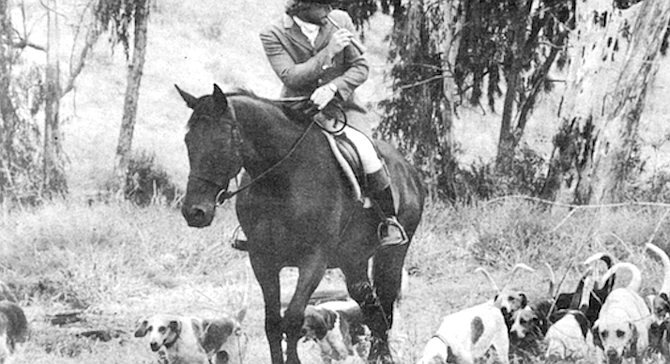
Where there are thousands of acres of undeveloped countryside— rolling terrain sheltering coyotes and foxes—where there are hounds and sleek horses and riders questing for adventure, foxhunting probably is inevitable. But it still seems so incredible in San Diego County.
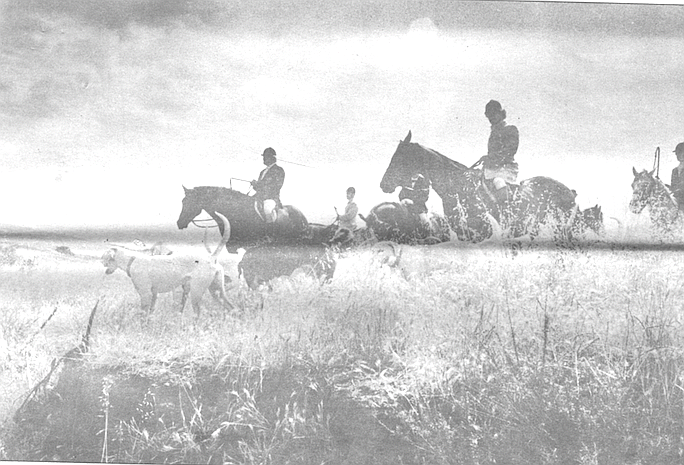
Out on Rancho Rondo, east of Del Mar, where the local foxhunting club bases its kennels, the anachronisms loom enormous. The chaparral-covered hills, the distant mountains, the hot blue skies could leap right out of any cowboy movie. Yet the riders who pound through the dust wear formal coats and bowler hats and neck scarves: an ancient uniform born on a different continent. Jets flash overhead and power lines dot the horizon, but the hunters follow a rigid, grueling routine established hundreds of years ago: the ritual of the sport of kings.
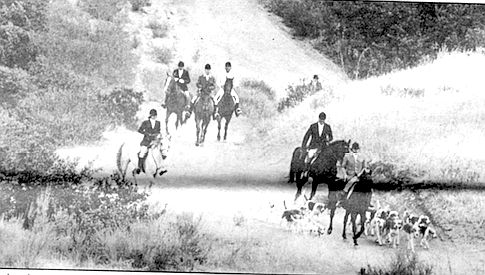
Harry Polonitza, president of the local club, the Santa Fe Hunt, says he’s used to people expressing disbelief over the existence of local foxhunting; the reaction is understandable. The sport is old and complex and it’s not something most people grow up with. Moreover, Polonitza says the San Diego club has kept a low profile since its inception, spurred mainly by fear of environmentalists' complaints.
San Diego riders first were introduced to foxhunting about eight years ago by Sol Rosenthal, a Midwestern doctor who moved here and saw the possibilities for the sport. From a small nucleus, the original group has grown to its current 26 members.
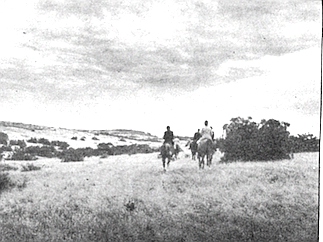
The sport of kings makes for almost royal expenses, however, and Polonitza says the group needs new members to help support the financial burden. He'd like to see the club include about 50 people, a number which should easily be able to produce the 30 or so riders optimal for the weekly hunts.
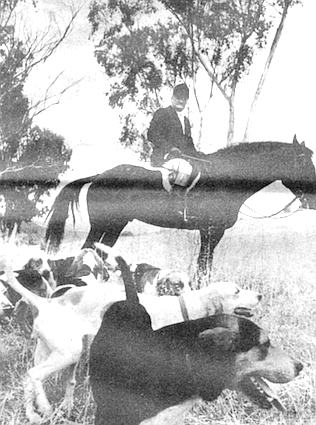
A white-haired, virile-looking man with skin tanned to the color of leather, Polonitza is forthright in discussing the sport. As the club’s new leader, he has moved to let more people know about the hunt, and the board of directors recently agreed to allow any interested person to join the daily ride with the hounds as a guest during August and September.
Looking out at the vast landscape surrounding the kennels, Polonitza smiles at the thought. He figures just the taste of the chase will hook new riders; they’ll see why San Diego suits foxhunting so well.
First, the county boasts enormous quantities of open land; Polonitza estimates the club regularly receives permission to ride on about 135,000 acres ranging from Borrego Springs to the Mexican border to just a few miles from the coast. The Daley Corporation allows the club to hunt its Rancho Jamul, and the Teamsters have opened their Los Penas-quitos Ranch to the group. Rancho Rondo and Rancho Corta de Madera are other favorite riding grounds. Polonitza says the fox-hunters take care not to disturb grazing cattle, and club members even argue, tongue-in-cheek, that their horses contribute natural fertilizer to the terrain.
San Diego County riders also don’t have to worry about the weather problems which often plague their brothers back East, where foxhunting has its strongest American roots. (The oldest foxhunting center, Geneseo, New York, this year saw 16-foot snowdrifts, for example, discouraging even to the hardiest hoof and hound.) The foxhunting season in San Diego runs from December through April, Polonitza explains, and it opens with an almost European pageantry.
Dressed in formal traditional apparel, club members gather at the show ring at Rancho Bernardo, where they meet Monsignor Spain of Solana Beach. Fully robed, the cleric blesses first hounds, then horses, then riders. After sharing a toast, the riders mount to begin their first chase pf the season.
The club’s huntsman and its only full-time employee is Dennis Dale, a sun-bronzed young man who’s foxhunted since he was nine. Dale gets so enthusiastic describing the hunt that he almost stumbles over his words. “You have to remember that it’s only been in the last 70 or 80 years that man hasn’t had the need for a pack of hounds to help with any sort of hunting. Foxhunting in England goes back to the late 1600s and the way we do it here isn’t very different from what you would have seen back then. We’re carrying on all the traditions.”
Rules governing clothing are the most rigorous. In the off-season. May through September, the hounds still need exercise, so a few diehard club members like Polonitza and Rosenthal turn out to ride and train them with Dale every Tuesday through Sunday. The regulations are most lax in the summer heat; riders can wear almost any type of clothes they want.
October and November, however, mark the “cubbing season" (when hunt preparations begin in earnest and Dale introduces new puppies to the pack). Here, “ratcatcher attire” is the rule: male riders wear rust-colored pants, brown or black boots, a sport shirt and tie. and a sport jacket; prescribed garb for women is similar. Once the formal season begins, all club members must wear the complete hunting uniform in order to participate. For most riders, that means the canary-yellow breaches, black boots, the black coat, and a top hat or derby. Staff members and distinguished hunters proudly bear the “pink” (scarlet) jackets and white pants, and everyone sports the “stock,” the white tie and gold pin worn around the neck.
Costumes are partly aesthetic, partly practical, says Polonitza. The variety of hunting hats usually are hardened, to guard against head injuries. Even the “stock” served a serious function in the days when rats thrived in the wild forests of England; should a rider fall and be bitten, he’d be wearing a ready-made bandage and pin. Riders and their trappings take a back seat, however, to the stars of the show, the hounds.
To hunt foxes, you use foxhounds, a sturdy breed of canines which look and sound like overgrown beagles. American foxhounds even share the beagle’s coloring; bronze ears and brown-dappled bodies. The English foxhound is a lighter, mottled cream color, and the San Diego club maintains a mix of about 30 dogs out at its kennels.
Dale discusses the dogs almost tenderly. He says they’ve been bred for more than 2,000 years to develop their hunting scent and cry and speed. They can cover up to 60 miles at a stretch, and he says “you can just about place a piece of bologna about a half mile upwind and they’ll smell it. Plus, they’re such really sweet animals that they make super pets.”
Puppies are placed in homes, where their caretakers develop the dogs’ personalities, then at six months to a year the hounds are added to the pack at cubbing season. Long before a hunt ever begins, it is Dale’s job to train the animals. The young hounds are physically linked to their elders so they can learn the ways of the field. Dale says it’s easy to spot when the dogs have struck off following a false scent, usually rabbit or deer or bobcat. “A rabbit track usually just goes for a short distance, and most often it runs around in circular patterns. Deer tracks usually run straight and over obstacles or brush. You also usually can see deer. The fox or coyote are a lot craftier; that’s why they’re so much fun.”
Hunt mornings begin early, about seven a.m.. when winter frost often clings to the brush. Animal scents, not yet baked away by the sun, still perfume the ground. The routine opens with Dale and usually three assistant riders (called whippers-in) “roding” the pack of hounds to a choice hunt location (herding them along in a tight, bobbing mass). With a verbal signal, Dale “casts” the dogs, urging them to fan out, which they do like shot from a gun. It may take a minute or it may take an hour, but one hound finally will sniff out a tantalizing aroma.
Dale discusses that moment using the archaic language of the sport. He says if the first hound to bay is a puppy, he might send an older hound to check up on him, but “if he’s an honest hound, you trust him. When a dog gives tongue and speaks to the line, if he speaks true, the other hounds will honor him. A good hound dog never lies.”
It is a moment that chills the blood, one that stirs the primeval instincts. At the sound of that first triumphant yelp, the other hounds, formerly silent, let loose their resounding chorus, racing across the field and crying with the joy of the chase. It is the moment for Dale to signal the “gone away"—a series of trills on his horn which alerts the other riders. All the while, whippers-in are scanning the field, aching to spot the coyote. Seeing him brings the ultimate drama; a chance to stand up in the stirrups, to doff one’s hat. to throw one’s whole arm in his direction and bellow. “Tallyho!”
The field of riders thunders after the pack, following signals both shouted and blasted through Dale’s horn. A few riders drop out of any race, first excusing themselves to the huntmaster. Those who remain commonly reach speeds up to 20 miles per hour, fused with the animals who must take hills and jumps in stride. The action can last two minutes or two hours before it repeats again, with two or three chases filling a morning.
Coyotes usually are the object of those chases. Red and gray foxes do live in San Diego County’s back country, but they’re rare; Polonitza says he’s only seen two in his six years of hunting. Dale says the coyote can run much faster than the fox, plus he’s stronger and can keep up the pace for longer distances. Yet the hunters yearn for the fox, and Dale explains; “The fox is more cunning; he’s really smart and he knows all sorts of tricks. Man’s hunted with hounds for 3,000 years and it’s the fox that’s always made the sport."
The foxhunters stress that the object is not to kill the creatures. They say in eight years they’ve chalked up only one coyote death, and that was accidental. The hounds are controlled by keeping them “fit but fat," according to the huntsman. “The coyote is out there foraging for food, but these dogs get dog food every day and they’re just no match for him; they simply can’t keep up with the coyote if he really wants to get away.” The huntsman tells tales of coyotes running circles around the dogs, of two coyotes taking turns leading the pack; and he talks in a tone of respect. “The coyote is such a noble beast. He lives off his strength and he knows every corner of the country. He’s got everything going for him.”
Should the hunted animal be caught, the pack will tear him apart, a prospect which the foxhunters genuinely seem to want to avoid (even though the sport does include an elaborate ritual for dealing with the dead animal, including anointing the riders’ foreheads with its blood). The question of cruelty haunts the riders and Polonitza confronts it. “We’re not out there with guns or bows and arrows. In actuality, we’re on an even par with them. Their cunning is sharper than ours. I’ve seen coyotes wait for us at the crest of a hill, just sitting and waiting and looking at us. So you've got to assume they must enjoy it, in some sense.”
The danger of the ride itself can discourage even some of the most accomplished show-ring riders. Polonitza downplays the hazards, however. “Sure, you get your people who say ‘There might be a squirrel hole out there. What if your horse stepped in it. What if this or that happenedT But those people also never would make cowboys. To my way of thinking, this is the most natural kind of riding there is. This is the way horses were meant to ride. And after just a few days of it, they fall into a natural pace. They really kind of come into their own."
The gut-grabbing. galloping thrill of the hunt, the sense of never knowing where a chase will lead, the cooperative union of men and horses and hounds all form the heart of foxhunting's appeal, an allure which Polonitza is betting will create more devotees through exposure alone. That allure has to be intense, since regular .club members have to lay out $350 in dues each year, not to mention the costs of apparel and associated horse expenses. For the money, however. Polonitza says they drink deeply of an experience which can't much longer grace the earth.
“That’s why I'm hunting so intensely now,” he says. “With more and more people, the space is going, and without the space you can’t hunt.l was out in the ring today, and I was bored. Showing your horse is fine for some people, but I don’t need a ribbon to tell me how well I can jump. I prove it every time I get out there and hunt. "


Where there are thousands of acres of undeveloped countryside— rolling terrain sheltering coyotes and foxes—where there are hounds and sleek horses and riders questing for adventure, foxhunting probably is inevitable. But it still seems so incredible in San Diego County.

Out on Rancho Rondo, east of Del Mar, where the local foxhunting club bases its kennels, the anachronisms loom enormous. The chaparral-covered hills, the distant mountains, the hot blue skies could leap right out of any cowboy movie. Yet the riders who pound through the dust wear formal coats and bowler hats and neck scarves: an ancient uniform born on a different continent. Jets flash overhead and power lines dot the horizon, but the hunters follow a rigid, grueling routine established hundreds of years ago: the ritual of the sport of kings.

Harry Polonitza, president of the local club, the Santa Fe Hunt, says he’s used to people expressing disbelief over the existence of local foxhunting; the reaction is understandable. The sport is old and complex and it’s not something most people grow up with. Moreover, Polonitza says the San Diego club has kept a low profile since its inception, spurred mainly by fear of environmentalists' complaints.
San Diego riders first were introduced to foxhunting about eight years ago by Sol Rosenthal, a Midwestern doctor who moved here and saw the possibilities for the sport. From a small nucleus, the original group has grown to its current 26 members.

The sport of kings makes for almost royal expenses, however, and Polonitza says the group needs new members to help support the financial burden. He'd like to see the club include about 50 people, a number which should easily be able to produce the 30 or so riders optimal for the weekly hunts.

A white-haired, virile-looking man with skin tanned to the color of leather, Polonitza is forthright in discussing the sport. As the club’s new leader, he has moved to let more people know about the hunt, and the board of directors recently agreed to allow any interested person to join the daily ride with the hounds as a guest during August and September.
Looking out at the vast landscape surrounding the kennels, Polonitza smiles at the thought. He figures just the taste of the chase will hook new riders; they’ll see why San Diego suits foxhunting so well.
First, the county boasts enormous quantities of open land; Polonitza estimates the club regularly receives permission to ride on about 135,000 acres ranging from Borrego Springs to the Mexican border to just a few miles from the coast. The Daley Corporation allows the club to hunt its Rancho Jamul, and the Teamsters have opened their Los Penas-quitos Ranch to the group. Rancho Rondo and Rancho Corta de Madera are other favorite riding grounds. Polonitza says the fox-hunters take care not to disturb grazing cattle, and club members even argue, tongue-in-cheek, that their horses contribute natural fertilizer to the terrain.
San Diego County riders also don’t have to worry about the weather problems which often plague their brothers back East, where foxhunting has its strongest American roots. (The oldest foxhunting center, Geneseo, New York, this year saw 16-foot snowdrifts, for example, discouraging even to the hardiest hoof and hound.) The foxhunting season in San Diego runs from December through April, Polonitza explains, and it opens with an almost European pageantry.
Dressed in formal traditional apparel, club members gather at the show ring at Rancho Bernardo, where they meet Monsignor Spain of Solana Beach. Fully robed, the cleric blesses first hounds, then horses, then riders. After sharing a toast, the riders mount to begin their first chase pf the season.
The club’s huntsman and its only full-time employee is Dennis Dale, a sun-bronzed young man who’s foxhunted since he was nine. Dale gets so enthusiastic describing the hunt that he almost stumbles over his words. “You have to remember that it’s only been in the last 70 or 80 years that man hasn’t had the need for a pack of hounds to help with any sort of hunting. Foxhunting in England goes back to the late 1600s and the way we do it here isn’t very different from what you would have seen back then. We’re carrying on all the traditions.”
Rules governing clothing are the most rigorous. In the off-season. May through September, the hounds still need exercise, so a few diehard club members like Polonitza and Rosenthal turn out to ride and train them with Dale every Tuesday through Sunday. The regulations are most lax in the summer heat; riders can wear almost any type of clothes they want.
October and November, however, mark the “cubbing season" (when hunt preparations begin in earnest and Dale introduces new puppies to the pack). Here, “ratcatcher attire” is the rule: male riders wear rust-colored pants, brown or black boots, a sport shirt and tie. and a sport jacket; prescribed garb for women is similar. Once the formal season begins, all club members must wear the complete hunting uniform in order to participate. For most riders, that means the canary-yellow breaches, black boots, the black coat, and a top hat or derby. Staff members and distinguished hunters proudly bear the “pink” (scarlet) jackets and white pants, and everyone sports the “stock,” the white tie and gold pin worn around the neck.
Costumes are partly aesthetic, partly practical, says Polonitza. The variety of hunting hats usually are hardened, to guard against head injuries. Even the “stock” served a serious function in the days when rats thrived in the wild forests of England; should a rider fall and be bitten, he’d be wearing a ready-made bandage and pin. Riders and their trappings take a back seat, however, to the stars of the show, the hounds.
To hunt foxes, you use foxhounds, a sturdy breed of canines which look and sound like overgrown beagles. American foxhounds even share the beagle’s coloring; bronze ears and brown-dappled bodies. The English foxhound is a lighter, mottled cream color, and the San Diego club maintains a mix of about 30 dogs out at its kennels.
Dale discusses the dogs almost tenderly. He says they’ve been bred for more than 2,000 years to develop their hunting scent and cry and speed. They can cover up to 60 miles at a stretch, and he says “you can just about place a piece of bologna about a half mile upwind and they’ll smell it. Plus, they’re such really sweet animals that they make super pets.”
Puppies are placed in homes, where their caretakers develop the dogs’ personalities, then at six months to a year the hounds are added to the pack at cubbing season. Long before a hunt ever begins, it is Dale’s job to train the animals. The young hounds are physically linked to their elders so they can learn the ways of the field. Dale says it’s easy to spot when the dogs have struck off following a false scent, usually rabbit or deer or bobcat. “A rabbit track usually just goes for a short distance, and most often it runs around in circular patterns. Deer tracks usually run straight and over obstacles or brush. You also usually can see deer. The fox or coyote are a lot craftier; that’s why they’re so much fun.”
Hunt mornings begin early, about seven a.m.. when winter frost often clings to the brush. Animal scents, not yet baked away by the sun, still perfume the ground. The routine opens with Dale and usually three assistant riders (called whippers-in) “roding” the pack of hounds to a choice hunt location (herding them along in a tight, bobbing mass). With a verbal signal, Dale “casts” the dogs, urging them to fan out, which they do like shot from a gun. It may take a minute or it may take an hour, but one hound finally will sniff out a tantalizing aroma.
Dale discusses that moment using the archaic language of the sport. He says if the first hound to bay is a puppy, he might send an older hound to check up on him, but “if he’s an honest hound, you trust him. When a dog gives tongue and speaks to the line, if he speaks true, the other hounds will honor him. A good hound dog never lies.”
It is a moment that chills the blood, one that stirs the primeval instincts. At the sound of that first triumphant yelp, the other hounds, formerly silent, let loose their resounding chorus, racing across the field and crying with the joy of the chase. It is the moment for Dale to signal the “gone away"—a series of trills on his horn which alerts the other riders. All the while, whippers-in are scanning the field, aching to spot the coyote. Seeing him brings the ultimate drama; a chance to stand up in the stirrups, to doff one’s hat. to throw one’s whole arm in his direction and bellow. “Tallyho!”
The field of riders thunders after the pack, following signals both shouted and blasted through Dale’s horn. A few riders drop out of any race, first excusing themselves to the huntmaster. Those who remain commonly reach speeds up to 20 miles per hour, fused with the animals who must take hills and jumps in stride. The action can last two minutes or two hours before it repeats again, with two or three chases filling a morning.
Coyotes usually are the object of those chases. Red and gray foxes do live in San Diego County’s back country, but they’re rare; Polonitza says he’s only seen two in his six years of hunting. Dale says the coyote can run much faster than the fox, plus he’s stronger and can keep up the pace for longer distances. Yet the hunters yearn for the fox, and Dale explains; “The fox is more cunning; he’s really smart and he knows all sorts of tricks. Man’s hunted with hounds for 3,000 years and it’s the fox that’s always made the sport."
The foxhunters stress that the object is not to kill the creatures. They say in eight years they’ve chalked up only one coyote death, and that was accidental. The hounds are controlled by keeping them “fit but fat," according to the huntsman. “The coyote is out there foraging for food, but these dogs get dog food every day and they’re just no match for him; they simply can’t keep up with the coyote if he really wants to get away.” The huntsman tells tales of coyotes running circles around the dogs, of two coyotes taking turns leading the pack; and he talks in a tone of respect. “The coyote is such a noble beast. He lives off his strength and he knows every corner of the country. He’s got everything going for him.”
Should the hunted animal be caught, the pack will tear him apart, a prospect which the foxhunters genuinely seem to want to avoid (even though the sport does include an elaborate ritual for dealing with the dead animal, including anointing the riders’ foreheads with its blood). The question of cruelty haunts the riders and Polonitza confronts it. “We’re not out there with guns or bows and arrows. In actuality, we’re on an even par with them. Their cunning is sharper than ours. I’ve seen coyotes wait for us at the crest of a hill, just sitting and waiting and looking at us. So you've got to assume they must enjoy it, in some sense.”
The danger of the ride itself can discourage even some of the most accomplished show-ring riders. Polonitza downplays the hazards, however. “Sure, you get your people who say ‘There might be a squirrel hole out there. What if your horse stepped in it. What if this or that happenedT But those people also never would make cowboys. To my way of thinking, this is the most natural kind of riding there is. This is the way horses were meant to ride. And after just a few days of it, they fall into a natural pace. They really kind of come into their own."
The gut-grabbing. galloping thrill of the hunt, the sense of never knowing where a chase will lead, the cooperative union of men and horses and hounds all form the heart of foxhunting's appeal, an allure which Polonitza is betting will create more devotees through exposure alone. That allure has to be intense, since regular .club members have to lay out $350 in dues each year, not to mention the costs of apparel and associated horse expenses. For the money, however. Polonitza says they drink deeply of an experience which can't much longer grace the earth.
“That’s why I'm hunting so intensely now,” he says. “With more and more people, the space is going, and without the space you can’t hunt.l was out in the ring today, and I was bored. Showing your horse is fine for some people, but I don’t need a ribbon to tell me how well I can jump. I prove it every time I get out there and hunt. "
Comments